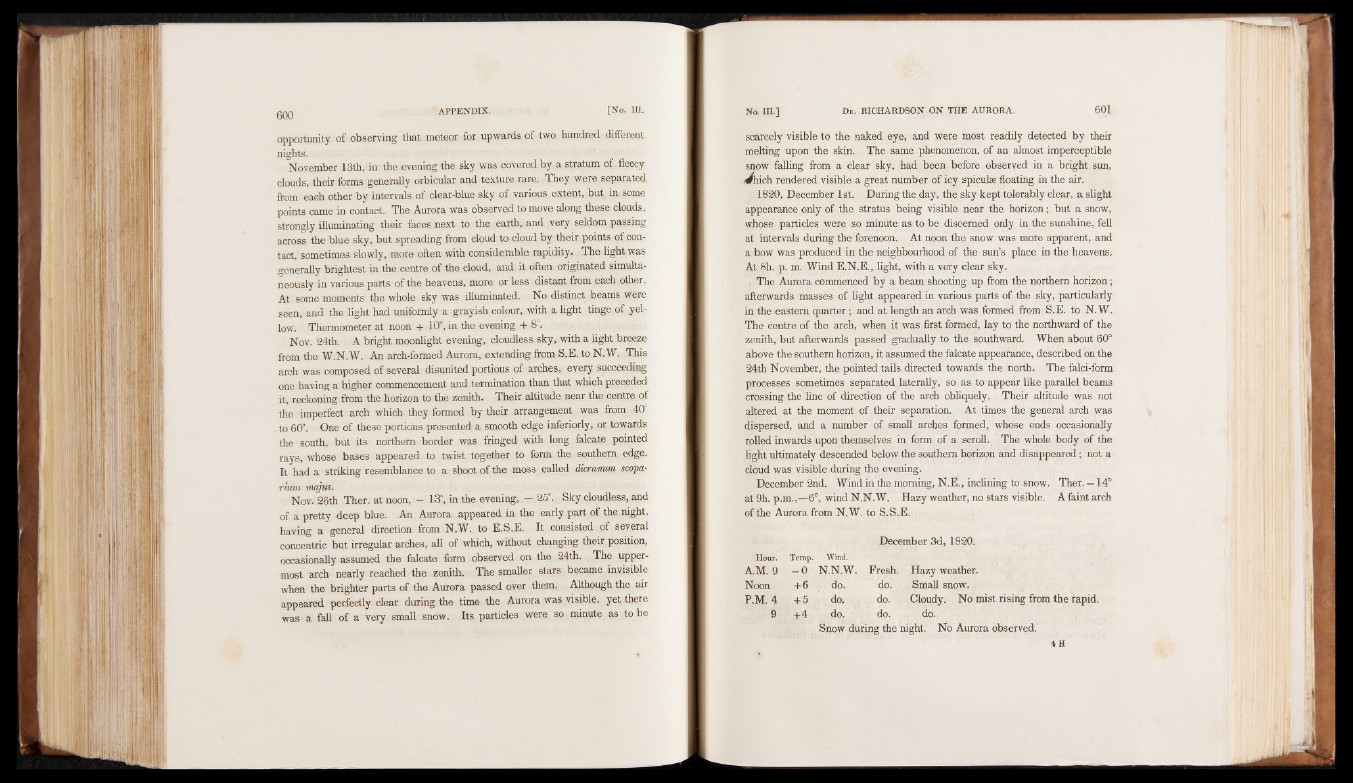
opportunity of observing that meteor for upwards of two hundred different
nigNhotsv.ember 13th, in the evening the sky was covered by a stratum of fleecy
clouds, their forms generally orbicular and texture rare. They were separated
from each other by intervals of clear-blue sky of various extent, but in some
points came in contact. The Aurora was observed to move along these clouds,
strongly illuminating their faces next to the earth, and very seldom passing
across the blue sky, but spreading from cloud to cloud by their points of contact,
sometimes slowly, more often with considerable rapidity. The light was
generally brightest in the centre of the cloud, and it often originated simultaneously
in various parts of the heavens, more or less distant from each other.
At some moments the whole sky was illuminated. No distinct beams were
seen, and the light had uniformly a grayish colour, with a light tinge of yellow.
Thermometer at noon + 10“; in the evening +..{&• ah
Nov. 24th. A bright moonlight evening, cloudless sky, with a light breeze
from the W.N.W. An arch-formed Aurora, extending from S.E. to N.W. This
arch was composed of several disunited portions of arches, every succeeding
one having a higher commencement and termination than that which preceded
it, reckoning from the horizon to the zenith, Their altitude near the centre of
the imperfect arch which they formed by their arrangement was from 40
, to 60°. One of these portions presented a smooth edge inferiorly, or towards
the south, but its northern border was fringed with long falcate pointed
rays, whose bases appeared to twist together to form the southern edge.
It had a striking resemblance to a shoot of the moss called dicranum scopa-
riwNmo vm. a2ju6st.h Ther. at noon, - 13°, in the evening, — 25°. Sky cloudless, and
of a pretty deep blue. An Aurora appeared in the early part of the night,
having a general direction from N.W. to E.S.E. It consisted of several
concentric but irregular arches, all of which, without changing their position,
occasionally assumed the falcate form observed on the 24th. The uppermost
arch nearly reached the zenith. The smaller stars became invisible
when the brighter parts of the Aurora passed over them. Although the air
appeared perfectly clear during the time the Aurora was visible, yet there
was a fall of a very small snow. Its particles were so minute as to be
scarcely visible to the naked eye, and were most readily detected by their
melting upon the skin. The same phenomenon, of an almost imperceptible
snow falling from a clear sky, had been before observed in a bright sun,
Jthich rendered visible a great number of icy spicul* floating in the air.
1820, December 1st. During the day, the sky kept tolerably clear, a slight
appearance only of the stratus being visible near the horizon; but a snow,
whose particles were so minute as to be discerned only in the sunshine, fell
at intervals during the forenoon. At noon the snow was more apparent, and
a bow was produced in the neighbourhood of the sun’s place in the heavens.
At 8h. p. m. Wind E.N.E., light, with a very clear sky.
The Aurora commenced by a beam shooting up from the northern horizon;
afterwards masses of light appeared in various parts of the sky, particularly
in the eastern quarter; and at length an arch was formed from S.E. to N.W.
The centre of the arch, when it was first formed, lay to the northward of the
zenith, but afterwards passed gradually to the southward. When about 60°
above the southern horizon, it assumed the falcate appearance, described on the
24th November, the pointed tails directed towards the north. The falci-form
processes sometimes separated laterally, so as to appear like parallel beams
crossing the line of direction of the arch obliquely. Their altitude was not
altered at the moment of their separation. At times the general arch was
dispersed, and a number of small arches formed, whose ends occasionally
rolled inwards upon themselves in form of a scroll. The whole body of the
light ultimately descended below the southern horizon and disappeared; not a
cloud was visible during the evening.
December 2nd. Wind in the morning, N.E., inclining to snow. Ther.— 14°
at 9h. p.m.,—6°, wind N.N.W. Hazy weather, no stars visible. A faint arch
of the Aurora from N.W. to S.S.E.
December 3d, 1820.
Hour.
A.M. 9
Temp.
- 0
Wind.
N.N.W. Fresh. Hazy weather.
Noon +6 do. do. Small snow.
P.M. 4 +5 do. do. Cloudy. No mist rising from the rapid.
9 +4 do. do. do.
Snow during the night. No Aurora observed.